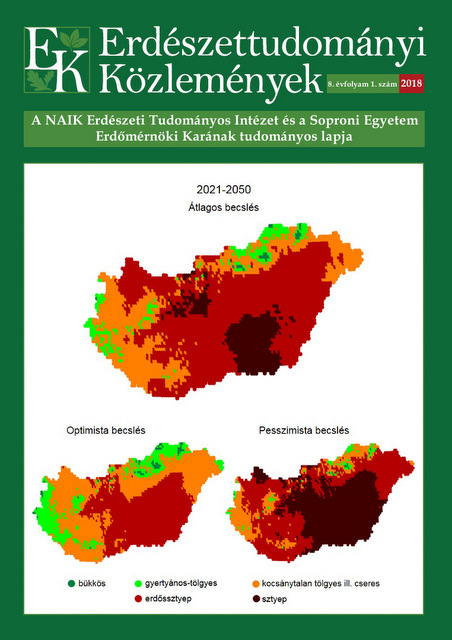| 1. | Mauri A., Strona G. & San-Miguel-Ayanz J. 2017: EU-Forest, a high-resolution tree occurrence dataset for Europe. Scientific Data 4: 160123. DOI: 10.1038/sdata.2016.123 |
| 2. | Barcza Z., Bartholy J., Mészáros R., Pongrácz R. & Radics K. 2011: Globális és európai tendenciák. In: Bartholy J., Bozó L. & Haszpra J. (eds): KLÍMAVÁLTOZÁS – 2011 Klímaszcenáriók a Kárpát-medence térségére. Magyar Tudományos Akadémia és az Eötvös Loránd Tudományegyetem Meteorológiai Tanszéke, Budapest, 99–144. |
| 3. | Bartha D. 1999: Bewertung der Dendroflora Europas auf Grund der Lebensformen. Tilia 7(Suppl.): 3–30. |
| 4. | Bartha D., Bölöni J., Ódor P., Standovár T., Szmorad F. & Tímár G. 2003: A magyarországi erdők természetességének vizsgálata. Erdészeti Lapok 138(3): 73–75. full text |
| 5. | Bartha D. 2005: Tájállapotok és vegetációállapotok, mint az erdőtermészetességi vizsgálatok viszonyítási alapjai. Tájökológiai Lapok 3(2): 253–274. full text |
| 6. | Bartha D. 2012: Növényföldrajz és társulástan. Egyetemi jegyzet. Nyugat-magyarországi Egyetem Kiadó, Sopron. |
| 7. | Bartha D. & Csiszár Á. 2012: Nyugati ostorfa (Celtis occidentalis L.). In: Csiszár Á. (ed): Inváziós növényfajok Magyarországon. Nyugat-magyarországi Egyetem Kiadó, Sopron, 109–113. |
| 8. | Bartha D., Korda M., Kovács G. & Tímár G. 2014: A potenciális természetes erdőtársulások és az aktuális faállománytípusok összevetése országos szinten. Erdészettudományi Közlemények 4(1): 7–21. full text |
| 9. | Bartha D., Király G., Schmidt D., Tiborcz V., Barina Z., Csiky J., et al. (eds) 2015: Magyarország edényes növényfajainak elterjedési atlasza. Nyugat-magyarországi Egyetem Kiadó, Sopron. |
| 10. | Bartholy J., Bihari Z., Horányi A., Krüzselyi I., Lakatos M., Pieczka I., et al. 2011: Hazai éghajlati tendenciák. In: Bartholy J., Bozó L. & Haszpra J. (eds). KLÍMAVÁLTOZÁS – 2011 Klímaszcenáriók a Kárpát-medence térségére. Magyar Tudományos Akadémia és az Eötvös Loránd Tudományegyetem Meteorológiai Tanszéke, Budapest, 145–234. |
| 11. | Berki I., Móricz N., Rasztovits E. & Vig P. 2007: A bükk szárazság tolerancia határának meghatározása. In: Mátyás Cs. & Vig P. (eds): Erdő és klíma V. Nyugat-Magyarországi Egyetem, Sopron, 213–228. |
| 12. | Borhidi A.1993: A Magyar Flóra szociális magatartás típusai, természetességi és relatív ökológiai értékszámai. Janus Pannonius Tudományegyetem, Pécs. |
| 13. | Caudullo G. & de Rigo D. 2016: Fraxinus ornus in Europe: distribution, habitat, usage and threats. In: San-Miguel-Ayanz J., de Rigo D., Caudullo G., Houston Durran T. & Mauri A. (eds): European Atlas of Forest Tree Species. The Publications Office of the European Union, Luxembourg, 100–101. |
| 14. | De Cáceres M. & Legendre P. 2008: Beals smoothing revisited. Oecologia 156(3): 657–669. DOI: 10.1007/s00442-008-1017-y |
| 15. | Führer E. 2010: A fák növekedése és a klíma. Klíma-21 Füzetek 61: 98–107. |
| 16. | Hamann A., Wang T., Spittlehouse D.L. & Murdock T.Q. 2013: A comprehensive, high-resolution database of historical and projected climate surfaces for western North America. Bulletin of the American Meteorological Society 94: 1307–1309. DOI: 10.1175/bams-d-12-00145.1 |
| 17. | Hoegh-Guldberg O., Hughes L., McIntyre S., Lindenmayer D.B., Parmesan C., Possingham H.P., et al. 2008: Assisted colonization and rapid climate change. Science 321(5887): 345–346. DOI: 10.1126/science.1157897 |
| 18. | Somodi I., Molnár Zs., Czúcz B., Bede-Fazekas Á., Bölöni J., Pásztor L., et al. 2017: Implementation and application of Multiple Potential Natural Vegetation models – a case study of Hungary. Journal of Vegetation Science 28(6): 1260–1269. DOI: 10.1111/jvs.12564 |
| 19. | Király G. & Horváth F. 2000: Magyarország flórájának térképezése: lehetőségek a térképezés hálórendszerének megválasztására. Kitaibelia 5(2): 357–368. |
| 20. | Király G. 2003: A magyarországi flóratérképezés módszertani alapjai. Flora Pannonica 1(1): 3–20. |
| 21. | Kotroczó Zs., Krakomperger Zs., Papp M., Bowden R.D. & Tóth J.A. 2007: A Síkfőkúti cseres-kocsánytalan tölgyes szerkezetének és fajösszetételének hosszútávú változása. Természetvédelmi Közlemények 13: 93–100. |
| 22. | McLachlan J.S., Hellmann J.J. & Schwartz M.W. 2007: A framework for debate of assisted migration in an era of climate change. Conservation Biology 21: 297–302. DOI: 10.1111/j.1523-1739.2007.00676.x |
| 23. | Mátyás Cs. 2009: Ecological challenges of climate change in Europe’s continental, drought- threatened Southeast. In: Groisman P.Y., Ivanov S.V. (eds): Regional Aspects of Climate-Terrestrial-Hydrologic Interactions in Non-boreal Eastern Europe. NATO Science for Peace and Security Series C: Environmental Security. Springer, Dordrecht, 35–46. DOI: 10.1007/978-90-481-2283-7_5 |
| 24. | Mátyás Cs., Führer E., Berki I., Csóka Gy., Drüszler Á., Lakatos F., et al. 2010: Erdők a szárazsági határon. Klíma-21 Füzetek 61: 84–97. |
| 25. | Molnár Cs., Molnár Zs., Barina Z., Bauer N., Biró M., Bodonczi L., et al. 2008: Vegetation-based landscape-regions of Hungary. Acta Botanica Hungarica 50(Suppl.): 47–58. |
| 26. | Molnár M. & Lakatos F. 2007: A bükkpusztulás Zala-megyében – klímaváltozás? In: Mátyás Cs. & Vig P. (eds): Erdő és klíma V. Nyugat-Magyarországi Egyetem, Sopron, 257–267. |
| 27. | Niklfeld H.1971: Bericht über die Kartierung der Flora Mitteleuropas. Taxon 20: 545–571. DOI: 10.2307/1218258 |
| 28. | Richardson D.M., Hellmann J.J., McLachlan J.S., Sax D.F., Schwartz M.W., Gonzalez P., et al. 2009: Multidimensional evaluation of managed relocation. Proceedings of the National Academy of Sciences of the United States of America 106: 9721–9724. DOI: 10.1073/pnas.0902327106 |
| 29. | Roloff A. & Bärtels A. 2006: Flora der Gehölze. Ulmer Verlag, Stuttgart. |
| 30. | Schwartz M.W. 2012: Using niche models with climate projections to inform conservation management decisions. Biological Conservation 155:149–156. DOI: 10.1016/j.biocon.2012.06.011 |
| 31. | Somogyi Z. 2007: A klíma, a klímaváltozás és a fanövedék néhány összefüggéséről. In: Mátyás Cs. & Vig P. (eds): Erdő és klíma V. Nyugat-Magyarországi Egyetem, Sopron, 295–306. |
| 32. | Standovár T., Bán M. & Kézdy P. (eds) 2017: Erdőállapot-értékelés középhegységi erdeinkben. (Forest state assessment in submontane woodlands.) Duna-Ipoly Nemzeti Park Igazgatóság, Budapest. |
| 33. | URL1: Andreas Hamann's personal website / ClimateEU: historical and projected climate data for Europe. (letöltve: 2018. 08. 01) URL |
